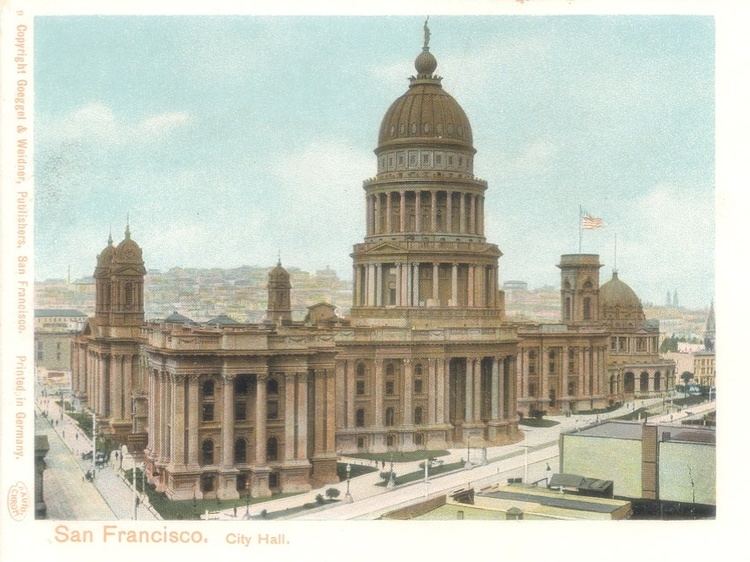 | ||
The San Francisco riot of 1877 was a two-day pogrom waged against Chinese immigrants in San Francisco, California by the city's majority white population from the evening of July 23 through the night of July 24, 1877. The ethnic violence which swept Chinatown resulted in four deaths and the destruction of more than $100,000 worth of property belonging to the city's Chinese immigrant population.
Contents
Background
From 1873 through the rest of the 1870s a severe economic crisis swept the United States of America known to history as the Long Depression. Economic contraction in the eastern United States proved the motivation for many to pull up stakes and try to reestablish themselves in the West coast mecca of California. Indeed, between the years 1873 and 1875 an estimated 150,000 workers made their way to the "Golden State," many of whom settled in the state's only metropolis, San Francisco.
By 1877 the depression that had already long plagued the East Coast arrived on the West Coast as well, and San Francisco's unemployment rate skyrocketed. There was no city or state central labor authority, no government provision for unemployed workers, and discontent was rampant.
A meeting was called for the evening of July 23, 1877, by the fledgling Workingmen's Party of the United States to agitate on behalf of the needs of the labor movement and those of unemployed workers in particular. City authorities granted permission for the gathering, which was to be held on vacant lots adjoining the new San Francisco City Hall.
As the day of the scheduled mass meeting arrived rumors were rampant in the city, including one that arson was being planned to destroy the docks of the Pacific Mail Steamship Company – the chief mode of transport of immigrant workers from China to the USA – as well as an attack on the city's Chinese quarter. Nevertheless, no city officials or political leaders attempted to intervene and the July 23 meeting proceeded as scheduled.
The riot
Nearly 8,000 people turned up for the socialist meeting at the so-called "sand-lots" in front of City Hall. Several representatives of the Workingmen's Party addressed the throng on the labor question, but none of them so much as mentioned the city's Chinese population, let alone attempted to lay blame upon them as the cause of the unemployment problem.
Historian Selig Perlman recounts the origin of the riot which followed:
"Everything was orderly until an anti-coolie procession pushed its way into the audience and insisted that the speakers say something about the Chinese. This was refused and thereupon the crowd which had gathered on the outskirts of the meeting attacked a passing Chinaman and started the cry, 'On to Chinatown.'"
Mayhem ensued, resulting in a two-day riot which claimed four lives and inflicted more than $100,000 worth of property damage upon the city's Chinese immigrant population. Twenty Chinese-owned laundries were destroyed in the violence and San Francisco's Chinese Methodist Mission suffered smashed glass when the mob pelted it with rocks.
The ethnic violence was only halted on the night of July 24 through the combined efforts of police, the state militia, and as many as 1,000 members of citizen's vigilance committee, each armed with a hickory pickaxe handle.
Aftermath and legacy
The July 1877 San Francisco riot's suppression did not mark the end of anti-Chinese activity in the city, but rather the beginning. One of those who had served in the so-called "Pick-Handle Brigade" which had helped to quell the rioting, an Irish wagon-driver named Denis Kearney, was drawn into political activity by the July events.
Kearney first applied for membership in the Workingmen's Party (later known as the Socialist Labor Party of America), but was denied on the basis of his outspoken public views on what he considered the "laziness" and "shiftlessness" of the working class. Stymied from membership in the existing opposition political party, Kearney started a new organization of his own, the Workingmen's Trade and Labor Union of San Francisco, which made use of the mobilizing slogan "The Chinamen Must Go!" This organization changed its name in October 1877 to the Workingmen's Party of California, of which Kearney served as president. The new party retained the anti-Chinese focus and slogans of the earlier organization.
Anti-Chinese sentiment spread throughout the United States, culminating in the effective termination of importation of Chinese workers through passage of the Chinese Exclusion Act in 1882.
